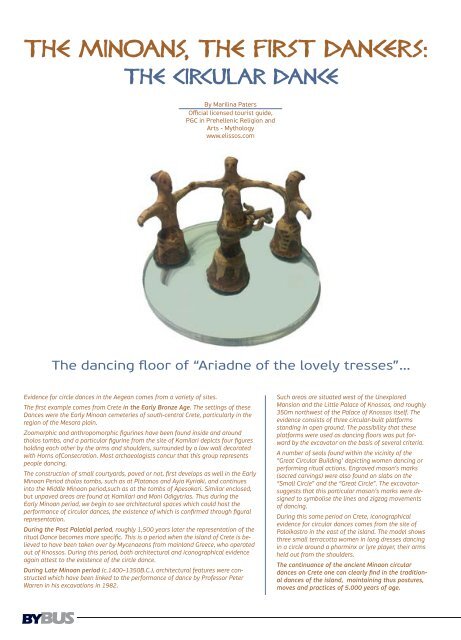ByBus Summer 2014
- No tags were found...
Create successful ePaper yourself
Turn your PDF publications into a flip-book with our unique Google optimized e-Paper software.
THE MINOANS, THE FIRST DANCERS:<br />
THE CIRCULAR DANCE<br />
By Marilina Paters<br />
Official licensed tourist guide,<br />
PGC in Prehellenic Religion and<br />
Arts - Mythology<br />
www.elissos.com<br />
The dancing floor of “Ariadne of the lovely tresses”…<br />
Evidence for circle dances in the Aegean comes from a variety of sites.<br />
The first example comes from Crete in the Early Bronze Age. The settings of these<br />
Dances were the Early Minoan cemeteries of south-central Crete, particularly in the<br />
region of the Mesara plain.<br />
Zoomorphic and anthropomorphic figurines have been found inside and around<br />
tholos tombs, and a particular figurine from the site of Kamilari depicts four figures<br />
holding each other by the arms and shoulders, surrounded by a low wall decorated<br />
with Horns ofConsecration. Most archaeologists concur that this group represents<br />
people dancing.<br />
The construction of small courtyards, paved or not, first develops as well in the Early<br />
Minoan Period tholos tombs, such as at Platanos and Ayia Kyriaki, and continues<br />
into the Middle Minoan period,such as at the tombs of Apesokari. Similar enclosed,<br />
but unpaved areas are found at Kamilari and Moni Odigytrias. Thus during the<br />
Early Minoan period, we begin to see architectural spaces which could host the<br />
performance of circular dances, the existence of which is confirmed through figural<br />
representation.<br />
During the Post Palatial period, roughly 1,500 years later the representation of the<br />
ritual Dance becomes more specific. This is a period when the island of Crete is believed<br />
to have been taken over by Mycenaeans from mainland Greece, who operated<br />
out of Knossos. During this period, both architectural and iconographical evidence<br />
again attest to the existence of the circle dance.<br />
During Late Minoan period (c.1400–1350B.C.), architectural features were constructed<br />
which have been linked to the performance of dance by Professor Peter<br />
Warren in his excavations in 1982.<br />
Such areas are situated west of the Unexplored<br />
Mansion and the Little Palace of Knossos, and roughly<br />
350m northwest of the Palace of Knossos itself. The<br />
evidence consists of three circular-built platforms<br />
standing in open ground. The possibility that these<br />
platforms were used as dancing floors was put forward<br />
by the excavator on the basis of several criteria.<br />
A number of seals found within the vicinity of the<br />
“Great Circular Building’ depicting women dancing or<br />
performing ritual actions. Engraved mason’s marks<br />
(sacred carvings) were also found on slabs on the<br />
“Small Circle” and the “Great Circle”. The excavatorsuggests<br />
that this particular mason’s marks were designed<br />
to symbolise the lines and zigzag movements<br />
of dancing.<br />
During this same period on Crete, iconographical<br />
evidence for circular dances comes from the site of<br />
Palaikastro in the east of the island. The model shows<br />
three small terracotta women in long dresses dancing<br />
in a circle around a phorminx or lyre player, their arms<br />
held out from the shoulders.<br />
The continuance of the ancient Minaon circular<br />
dances on Crete one can clearly find in the traditional<br />
dances of the island, maintaining thus postures,<br />
moves and practices of 5.000 years of age.
















